
Publisher:
Bonnie King
CONTACT:
Newsroom@Salem-news.com
Advertising:
Adsales@Salem-news.com

~Truth~
~Justice~
~Peace~
TJP
May-21-2011 23:59


 TweetFollow @OregonNews
TweetFollow @OregonNews
Sri Lanka Tamil Genocide: Killing the Messenger
Tim King Salem-News.comSlaughter of Pro-Tamil Journalists dimmed world's view of Sri Lanka Genocide. Warning: graphic images.
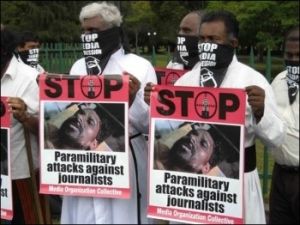 Photo: TamilNet |
(SALEM, Ore.) - One sure way to keep a national genocide out of world view is to slay the journalists who would reveal the information.
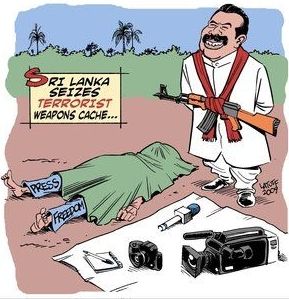 Artwork by the amazing Carlos Latuff, friend of |
Sri Lanka's president subscribes to this idea and as a result, from the time he took office in 2005 until the 2009, when the Sri Lankan government crushed the Tamil resistance; between 20,000 and 100,000 people were killed. By some accounts up to 146,000 Tamil people were disappeared or killed. Severe incidents of cruelty were widely reported and documented[1].
One of the first things Sri Lanka Pres. Mahinda Rajapaksa did after entering office, was shatter the fragile peace that existed in his country[2].
This was one thought on the minds of Tamil people and their supporters this week, as they observed the Tamil Genocide of Sri Lanka that culminated in 2009 at the conclusion of the country's long-running civil war.
A western-backed program to classify Tamil people serving in the LTTE (Liberation Tigers of Tamileelam) as 'terrorists' allowed the Sri Lankan government's slaughter of tens of thousands of civilians as well as military prisoners of war.
This isn't figurative, it isn't something to take lightly.
Dr. Higginbottom at the Mu'l'livaaykkaal Remembrance event, London |
As Dr Andrew Higginbottom, the Principal Lecturer in Politics/Human Rights at Kingston University in London, explained last Thursday at the city's Mu'l'livaaykkaal Remembrance event, that the British, Europeans and the similar world powers joined Rajapaksa, playing a dubious role in disarming the peace process:
"There was a peace process. But, visas were banned and the political status was denied to the Liberation Tigers of Tamil Eelam. They were branded as a terrorist organisation by the European Union under the prompting of Britain and United States and they deliberately broke the peace process, which had its horrible termination in the killing fields of Rajapaksa. So, there is co-responsibility."
He said this was not just any genocide; but that it was planned and what was planned was no secret among western governments.
And it is important to recall recent and current history; Afghanistan, Iraq, Palestine, Nicaragua, Panama, South Africa and Northern Ireland. In each case native people were murdered by military forces while defending their nation, their neighborhoods and families, from U.S. and/or British financed military operations (Yes this includes Israel and South Africa) and in each case the resistance is dubbed 'terrorist' and the rights of said individuals, who in another context are freedom fighters, are terminated over the distinction.
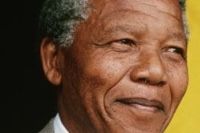 Mandela: a 'terrorist' according to the policies of |
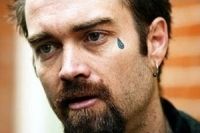 O'Keefe: Called a 'terrorist' for disarming Israeli |
Sometimes those terrorists turn out to be people like Nobel Prize Winner Nelson Mandela, and sometimes they are earth shakers deeply involved in world politics like our Correspondent Ken O'Keefe in Gaza who has and does continue to influence policy while at the same time helping the poorest and most unfortunate in a hands-on way.
It takes leaders of that caliber to pave the road for a better day, and the bridge crosses here again because both men I referred to above are prolific writers and chroniclers and their journalism absolutely opened the floodgates of interest for their respective causes, which are almost identical; South Africa and Palestine.
When the writer is killed the message sometimes dies too, and oppressors are well aware of this dynamic so they exploit it to the fullest extent.
Media Deaths: Rajapaksa Kills the Messengers
In my last report I talked about how Mahinda Rajapaksa, Sri Lanka's president, leads a country that, according to Reporters Sans Frontières / 'Reporters Without Borders' (RSF), was ranked at 165 of 173 listed in the annual Worldwide Press Freedom Index in 2008. Only eight of the world's known violators of press freedom ranked worse[3].
Reporters Sans Frontières / 'Reporters Without Borders'
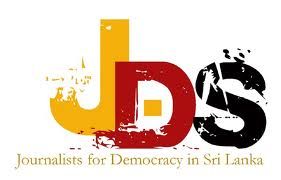 |
- In 2002, Sri Lanka was ranked as #51
- In 2003, Sri Lanka was ranked as #89
- In 2004, Sri Lanka was ranked as #110
- In 2005, Sri Lanka was ranked as #115
- In 2006, Sri Lanka was ranked as #141
 Visit: Reporters Without Borders |
(note from RSF: Things are much the same in Sri Lanka, which ranked 51st in 2002, when there was peace, but has now sunk to 141st because fighting between government and rebel forces has resumed in earnest. Dozens of Tamil journalists have been physically attacked after being accused by one side or the other of being biased against them.)[4]
The Civil War between the Tamil resistance and the Sri Lankan government began in 1983. The LTTE was first organized in 1976 by Vellupillai Prabhakaran.
The Tamil Tigers fought a secessionist campaign hoping to create Tamil Eelam; the proposed independent state in the north and east of Sri Lanka for Eelam Tamils of Sri Lanka, and also for Tamils of Indian origin.
However the violence worsened and by 1983 Sri Lanka was in a state of civil war.
This ended almost exactly three years ago.
2009 was a terrible year for the Tamil people.
This is the year that the airwaves went dark. Killing those who carry the information is one of the only proven methods of furthering illicit world politics.
It is time for the world to ask hard questions about the Genocidal events in Sri Lanka.
The most damning evidence comes in the form of photos and video that actually originated from the camera of a Sri Lanka soldier[5].
It is unknown if this particular soldier suffered from guilt and turned the video over, or if it surfaced some other way, regardless it did surface, about eight months after the carnage of 2009.
This is similar to the emergence of the images of My Lai in Vietnam, where U.S. soldiers slaughtered almost every resident in a village in a zone known to the Americans as 'Pinkville'.
The photos of the mass murder emerged after the particular soldier, Sgt. Ronald Haeberle, had returned home from the war. They soon became the subject of a Life magazine photo spread and largely influenced sentiment against an already vastly unpopular war[6].
The images of the Tamil Genocide in Sri Lanka are reminiscent of the Holocaust. Piles of bodies; summary executions recorded on tape as they happened; bodies of female rape victims being tossed into the back of a truck to be driven to their burials. The female victims are all nude, many are bound, and some are clearly not dead. One was a well-known news anchor; the identity of her body in video recorded after her death sent shock waves across the world journalism community.
Death of an Esteemed Reporter
Tamil Journalists and Media Workers Killed and severely injured in Sri Lanka 2000 - 200719 October 2000, Mylvaganam Nimalarajan, aged 38, well-known journalist and father of three, was shot dead in his own home, through the window of his room, as he wrote a news report. He was the Jaffna correspondent for the Tamil daily Virakesari, the independent Tamil radio station, Sooriyan FM, the popular Sinhala political weekly, Ravaya, the Tamil and Sinhala services of the BBC. He was also the Secretary of the Northern Journalists' Association. 31 May 2004, Mr. Aiyathurai Nadesan was shot dead by unidentified gunmen on a motorbike, while traveling on a motorcycle himself. The Batticaloa police launched an investigation into the killing. However, no suspect has ever been taken to court. Mr. Nadesan (48) was a renowned journalist who was very critical of the Sri Lanka Army and paramilitary groups in his widely read political column in the Sunday edition of the Virakesari. 29 April, 2005 Darmaratnam Sivaram (47), male, editorial board member of TamilNet / around 10:30pm/ abducted by 4 men in a white van in front of the Bambalapitya police station in Colombo, later his body was found near the parliamentary complex with in a high security zone. 29 July, 2005. Arasakumar Kannamuthu (38), male, a newspaper delivery agent for the Batticaloa Eelanatham newspaper shot and killed by unidentified gunmen at Matupola in Kalmunai-Akkaraipattu Road, 50 kilometers south of Batticaloa. 12 August, 2005 Tamil broadcaster Relangi Selvarajah and her husband, a political activist, were killed by unidentified gunmen in Colombo on the same day that Lakshman Kadirgamar, Sri Lanka's foreign minister, was assassinated. 29 August, 2005. David Selvaratnam (50), a security guard, Manickam Kamalanathan (49), a proof-reader, Subramaniyam Suthas (29), a computer operator, A.M.F Anas, a visiting employee, all are male / around 6:15pm. / severely injured by unidentified attackers throwing two grenades into the printing office of Tamil-language daily Sudar Oli, Madampitiya Road at Grandpass in Colombo. 30 September, 2005 Yogakumar Krishnapillai (38), male, a distributor of the Batticaloa-Eelanatham newspaper / around 7:30am / shot and killed by two unidentified gunmen in Batticaloa. 24 January, 2006 35-year old Subramaniam Sugirtharajan, a father of two and a correspondent for "Sudar Oli," a Tamil-language was shot and killed at his residence located along the Lower Road facing the Trincomalee harbor in the suburb of Orr's Hill in Trincomalee He was waiting for transport to his workplace. 02 May, 2006. a gang of five men armed with T-56 automatic rifles entered the Uthayan office at about 7.25 p.m. and began firing. Marketing manager Bastian George Sagayathas, 36, also known as Suresh, was the first killed. Circulation supervisor S. Ranjith, 25, was killed when he raised his head to see what was happening to Uthayakumar. He was held down and shot dead. 03 May, 2006 Suresh Kumar and Ranjith Kumar were killed on May 3, as journalists gathered in Colombo to celebrate Press Freedom Day this year. 02 July, 2006 freelance journalist Sampath Lakmal de Silva was shot dead by an unknown group. 27 July, 2006 Mariathas Manojanraj, 23, a distributor of Yarl Thinakural and Veerakesari, was killed in a claymore explosion on Rasa Road, near Nilavarai Deep well on his way from Atchuvely to Jaffna. Manojanraj was riding a motorbike to collect Thursday issues of the papers from the Jaffna Thinakkural office for distribution in Atchuvely when the explosion occurred, sources said. The claymore mine was triggered by remote-control device and occurred in an isolated area in Navakeeri close to the Ellalan Community Center, sources said. 12 August, 2006 Relangi Selvarajah and her husband were shot dead by unknown gunmen in Bambalapitiya. 15 August, 2006 Sathasivam Baskaram Driver/Distributor Uthayan Newspaper in Jaffna was shot and killed. 21 August, 2006. Sinnathamby Sivamaharajah (68), male, managing director of Tamil-language daily "Namathu Eelanadu, chairman of the Multi-Purpose Co-opeative Society (MPCS) in Tellippalai, Jaffna, former member of parliament for the Tamil United Liberation Front (TULF) / around 7:20pm/ shot and killed at temporary residence in Tellippalai, 14 kilometers northeast of Jaffna. 27 February, 2007 S. T. Gananathan (64), male, president of the Jaffna Multi Purpose Co-Operative Society / shot dead 200 meters from the Sri Lankan Army (SLA) camp at Mampalam junction in Ariyalai. 16 April, 2007 Subash Chandrabose, 32, editor of the Tamil monthly Nilam, was gunned down late Monday at his residence in Thirunavatkulam in Vavuniya, 260 kilometres north of Colombo, the rights group said. Chandrabose also freelanced for other publications including the London-based magazine Tamil World. The FMM, which consists of journalists and rights activists, said it was 'appalled by this killing.' 29 April, 2007 Selvarajah Rajivarman (25), male, journalist of Jaffna's 'Uthayan' newspaper / around 10am/ shot and killed by gunmen riding on a motorbike at Naavalar Road, Rasaavin Thoaddam junction in Jaffna. 01 August, 2007 Nilakshan Sahapavan, a 22-year-old student at the Jaffna University Media Research and Training Centre and the editor of Calare, was killed by unidentified gunmen. |
Dharmaretnam Sivaram was the driving force behind TamilNet, the Website for the Tamil Tigers, which became a useful tool for Tamils seeking critical information.
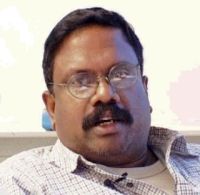 Dharmaretnam Sivaram |
Considered to be an active champion of Tamil nationalism, both prolific and controversial, he became a reporter after leaving his role with the People's Liberation Organisation of Tamil Eelam, a Tamil rebel outfit led by the charismatic left winger, Uma Maheswaran[7].
He also contributed to the Colombo-based English-language Daily Mirror and wrote columns in the Tamil media, including to the large-circulation Tamil daily, Virakesari. His work also appeared under the pseudonym Taraki.
"His pen started to undermine the Sinhala chauvinists’ ambitions just as the armed fighters did on the battlefield. That is why government terror was unleashed upon him."
Saluting the work of Dharmaretnam Sivaram, the popular Jaffna Tamil daily, Uthayan, said in its editorial Monday that he would remain an “inspiration to Tamil journalists with love for the nation and their people.”[8]
Regarding the death of Dharmaretnam Sivaram, the University Teachers for Human Rights (JAFFNA) in Sri Lanks said:
The life and death of journalist Dharmaretnam Sivaram reflect the advance of impunity on both sides of the ethnic divide. A number of Sinhalese intellectuals have rightly condemed Sivaram’s murder, pointing out that he challenged them in his writings, not with a gun and that it called for a civilised political response. But the story of Sivaram cannot be told without accounting for the deep-rooted and corrupting character of Sinhalese nationalism, and its equally corrupt Tamil counterpart. Both promote violence in the name of ‘our people’ and have made life miserable for all the people of Sri Lanka.[9]
The group XIX (Article 19) wrote at the time, that the murder of Dharmaretnam Sivaram in April 2005 happened as part of a series of attacks on freedom of expression in Sri Lanka. They reported at the time that his death was not an isolated incident.
"...this week alone, six extra-judicial killings have been linked to the conflict between the Tamil Tigers and the government. His murder is also a sad reminder of the increasing violence perpetrated against journalists throughout the world. According to journalist organisations, since the beginning of 2004, more than 70 journalists and media workers have lost their lives. Few if any of these murders have yet been resolved." [10]
2009: a Deadly Year for Media in Sri Lanka
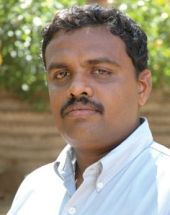 Punniyamurthy Sathyamurthy |
Perhaps because it is ultra personal, I view the killing of journalists as the most foul of acts. It is cheap, wrong, non-democratic, and for the purposes of Genocide, far too effective. Sri Lanka has demonstrated this.
One headline read:
Tamil journalist killed in bombardment amounting to "war crime"
Reporters Without Borders expressed revulsion 12 Feb. 2009 over the death of Tamil journalist Punniyamurthy Sathyamurthy, who died in a Sri Lankan Army bombardment on Thevipuram, Mullaithivu district in the region of Vanni, in what media at the time described as a "war crime".[11]
"Army air strikes and artillery fire on areas where there are tens of thousands of civilians, including Tamil journalists, are war crimes" the worldwide press freedom organisation said.
"The death of Sathyamurthy shows the extent to which witnesses to the military offensive have no protection. We call on the international community to secure a ceasefire to save the lives of these civilians," it added.
The journalist who was married and the father of a six-year old daughter, had worked for five years for Canadian Tamil Radio, Canadian Multicultural Radio and Tamil Vision International television, all based in Canada. His articles were regularly carried by websites and media of the Tamil diaspora[12].
Journalist Predicts Own Murder
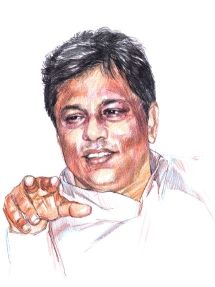 Lasantha Wickrematunge |
Jonathan Steele wrote about the death of Lasantha Wickrematunge in The Guardian, Tuesday 13 January 2009:
It is being called "the voice from the grave", a remarkable and accusing article written by one of Sri Lanka's best-known journalists and published days after he was murdered in a hail of gunfire.
In a 2,500 word editorial, Lasantha Wickrematunge foresaw his own death and hinted at the identity of the killers from within the ranks of Sri Lanka's government[13].
Steele described a gripping and detailed account of what he sees as his country's descent into persecution of citizens and flouting of democracy.
Lasantha Wickrematunge wrote:
"'When finally I am killed, it will be the government that kills me,' he wrote. Addressing Sri Lanka's president, Mahinda Rajapakse - a close friend - he says: 'In the wake of my death I know you will make all the usual sanctimonious noises and call upon the police to hold a swift and thorough inquiry. But like all the inquiries you have ordered in the past, nothing will come of this one, too. For truth be told, we both know who will be behind my death."
Wickrematunge was shot in the head in Sri Lanka's capital, Colombo, by two gunman on a motorcycle as he drove to work, in a manner very similar to the recent murder of Juliano Mer-Khamis[14].
Beyond Murder
The slaughtering of Tamil people did not stop at murder; it included bizarre acts of degrading sexual cruelty that are ten steps beyond horrifying. One of the victims of this inhumane conduct was 27-year-old Shoba, whose nom de plume was Isaippiriya.
 Shoba Isaippiriya |
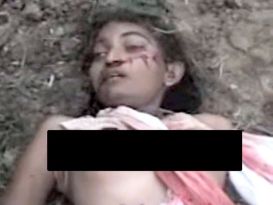 Isaippiriya was an LTTE media specialist |
Though identified by the Sri Lanka military as a 'Lieutenant Colonel' in the LTTE, Shoba actually suffered from health problems, never picked up a weapon, and was a media specialist with the LTTE who produced reports for TamilNet[15].
She was found stripped naked, with her hands tied behind her back, shot dead, as seen in a video released Channel-4. Shoba was the TamilNet Vanni correspondent. The group confirmed that she had never taken part in military operations:
“I am able to learn through those who have been at Mu'l'livaaykkaal in the final days of war, that Shoba remained unarmed and did not take part in combat," a source told TamilNet, adding that, Shoba lost her 6-month-old baby girl, named Akal, in the last stage of the war in Sri Lanka's indiscriminate bombardment on civilians.
Born in 1982, Isaippiriya attended Memorial School until Grade 5. She received a scholarship to attend Veampadi Girls High School in Jaffna until 1996.
Her family was displaced by war; they ended up in Vanni. Here Isaippiriya continued her studies until she joined the movement’s media division.
She was a gifted dancer, journalist, mother, wife and friend of many.
The loss of Isaippiriya is especially significant because she was a well-known media personality.
Yet her fate was the same as so many tens of thousands who perished violently and against their will, often in front of their parents and children, far before their earthly time was through.
I chose to highlight particular journalists who died or were very seriously wounded in 2009 and this is only a small sampling, tragically.
The sidebar on the right side with the journalist deaths that occurred between 2000 and 2007 contains a great degree of accuracy, though it may not name all of the individuals lost during those years.
In Conclusion
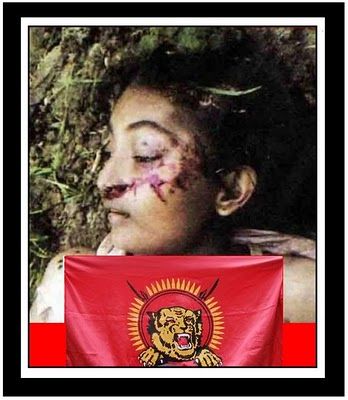
One of the worst excuses used by Sri Lanka in the entire conflict is that Tamils used civilians as 'human shields' and that is why so many died. That is one of the worst excuses ever suggested for human slaughter.
We should all feel insulted, and it is highly reminiscent of Israel's excuse today for committing atrocities against the Palestinian population. The term 'human shield' should be struck from our language.
And the next word to remove is 'terrorist'. It is completely misused terminology employed by western governments to demean and strip human rights from their perceived enemies, almost all of whom crossed swords with the U.S. over an economic matter relating to oil.
Both the U.S. government and Israel are the biggest purveyors of terrorism as defined by the Webster's Dictionary. Of course the LTTE Tamil Tigers were dubbed a 'terrorist' group and this should be the point in history when we move past this type of false excuse-based branding.
Genocide is the worst possible crime that can ever be committed against humanity and those responsible for it should be taken to task and tried for their crimes[16].
Unregulated governments that employ cruelty and public deception to win campaigns are the scourge of the earth and it is utterly deceiving, because these governments that commit state sponsored terrorism generally project their image in positive ways through controlled media.
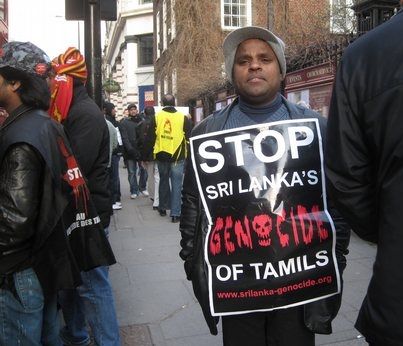
But when a government is willing to kidnap, rape and slaughter journalists, it reaches the boiling point. Even borderline supporters and many willing to look the other way over some military crimes, take notice when people like Dharmaretnam Sivaram, Punniyamurthy Sathyamurthy, Lasantha Wickrematunge and Shoba Isaippiriya are murdered.
The stories of the 'white vans' in Sri Lanka that disappear people routinely; the images of small children who were hanged by the neck until dead; pregnant women cut open; women who were raped and left bound; these haunt all world media, and the soldiers of Sri Lanka who participated in these heinous crimes are undoubtedly haunted by their realities of having participated. Their ranks today, like those of the Tamil survivors, must be swelling with Post Traumatic Stress Disorder (PTSD).
United Nations officials have made recent progress in researching this human calamity of Tamil people in Sri Lanka. Everything keeps pointing to Genocide, and the UN Human rights Commission needs to show the world that Genocidal crimes will never be tolerated, and that the people behind the ruthless slaughter of the Tamil people will be brought to justice, like Slobodan Milošević, former President of Serbia and Yugoslavia, and the Nazi leaders of the Third Reich, and others of their ilk. Real world justice, like Genocide, has no cultural or political favorites[17][18].
Maslow's hierarchy of needs
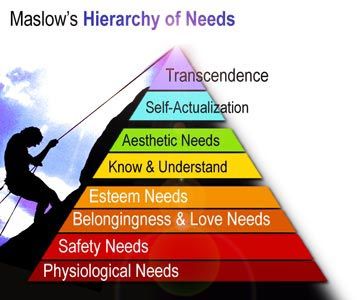
For me, all of this discussion; the Genocide that claimed tens of thousands of lives; one masked in utter secrecy due to the government's elimination of pro-Tamil journalists; the resulting Diaspora that left gaping holes in an entire culture and society, inevitably leads back to Maslow's hierarchy of needs; a theory in psychology, proposed by Abraham Maslow in his paper A Theory of Human Motivation.
Many psychology students are familiar with Abraham Maslow's hierarchy of needs, and the importance of this simple concept of human needs can not be overstated in a world so filled with grief. Wikipedia describes Maslow's hierarchy of needs as a pyramid consisting of five levels:
The lowest level is associated with physiological needs, while the uppermost level is associated with self-actualization needs, particularly those related to identity and purpose.
The higher needs in this hierarchy only come into focus when the lower needs in the pyramid are met. Once an individual has moved upwards to the next level, needs in the lower level will no longer be prioritized. If a lower set of needs is no longer be met, the individual will temporarily re-prioritize those needs by focusing attention on the unfulfilled needs, but will not permanently regress to the lower level.
For instance, a businessman at the esteem level who is diagnosed with cancer will spend a great deal of time concentrating on his health (physiological needs), but will continue to value his work performance (esteem needs) and will likely return to work during periods of remission.
The following excerpt from the Sunday Times reveals many of the specific war crime allegations against Sri Lanka. The link at the bottom takes you to the full report with more information, very worth the read:
01. As the need for humanitarian assistance rose, it was increasingly restricted by the Government. Attempts to broker a political settlement-or even a sufficient respite in the fighting to enable the civilians to reach safety-foundred.63. A potent symbol of these operations was the "white van". White vans were used to abduct and often disappear critics of the Government or those suspected of links with the LTTE, and more generally, to instill fear in the population. An elite unit within the Special Task force (STF) of the police is implicated in running these white van operations. Those abducted were removed to secret locations, interrogated and tortured in a variety of ways, including through beatings forced nudity suffocation with plastic bags. partial drowing extraction of finger or toe nails, or administering electric shocks. Many were killed and their bodies disposed of secretly. Human rights workers, journalists , news paper editors and humanitarian workers accused of being "Tiger sympathizers" were also caught in the net. In the period between 2006 and the end of the war, 66 humanitarian workers either disappeared or killed.
64. The strategy also involved stricter controls on the media and the flow of information, imposing a media blackout and stifling critical views of the war effort. From 2006 Independent journalists were not allowed to travel to LTTE controlled areas and certain journalists were named as "Tiger sympathizers" on the Ministry of Defence website
81. On or around 19 to 21 January, SLA shells hit Vallipuram hospital, located in the first NFZ, killing patients. Throughout the final stage of the war, virtually every hospital in the Vanni, whether permanent or makeshift, was hit by artillery. Particularly those which contained wounded LTTE were hit repeatedly.
84. In the early morning hours of 24 January, hundreds of shells rained down in the NFZ. Those with access to the United Nations bunker dove into it for protection, but most IDPs did not have bunkers and had nowhere to seek cover. People were screaming and crying out for help.The United Nations security officer, a highly experienced military officer, and others present discerned that the shelling was coming from the south, from SLA positions. He made frantic calls to the head of United Nations Security in Colombo and the Vanni Force Commander at his headquarters in Vavniya as well as the joint operations headquarters in Colombo, demanding that the shelling stop,which sometimes resulted in a temporary adjustable of the shelling before it started again. "Heavy shelling continued over night, and shells continued to hit the United Nations hub and the distribution centre, Killing numerous civilians.
101. At the time, the Defence Secretary stated: "We are taking casualties to prevent civilians getting hurt. This is a factor we are very concernd about. Otherwise we could have used so much artillery and just moved on. The Government announced on 25 February, and again on 27 April that the SLA was no longer using heavy weapons in the second and third no fire zones. But what was happening on the ground indicated the opposite. Intensive artillery fire had been a core tactic in the SLA's military campaign from the outset. As victory neared, this tactics was not abandoned, but rather its use was intensified, even though the LTTE was now immobilized and surrounded in an area of high civilian density. The intensive shelling also caused many civilians to attempt to flee the area, meeting another of the Government objectives to put pressure on civilians to get out of the way despite government pronouncements. Satellite images in Annex 3 show that SLA artillery batteries were constantly adjusted to increasingly target the NFZs. The LTTE had fewer heavy wepons left and less space to fire them from.
103. When the PTK hospital relocated to Putumattalan the Government stated that "there are now no hospitals functioning in uncleared areas in the Vanni. Nonetheless, the second NFZ had their makeshift hospital including Putumattalan, a small clinic at Valayanmadam and a hospital in Mullivaikal. All of their coordinates were known to the Government, and they were clearly marked with emblems. Government doctors continued providing their services there. Putumattalan hospital was severely overcrowded with hundreds of newly injured civilians. As the Government did not allow basic medical supplies into the Vanni, conditions in Pudumatalan hospital were so poor that a large number of amputations were performed without anesthetics, using butcher knives rather than scalpels, Sanitary pads and cotton clothes were used as bandages and intervenous drips were hung from the trees with several -injured patients lying on the ground under them. In spite of the significant efforts of the few available doctors many patients died due to lack of access to proper medical care and scores of bodies were deposited in front of the hospital each day
118. Due to the lack of space in the third NFZ civilians had nowhere to hide from the shelling which was coming in from all sides. Shells rained down everywhere and bullets whizzed through the air. Many died and were buried under their bunkers or shelters, without their deaths being recorderd. Black smoke and the stench of dead bodies filled the air. Some people begged food for their starving children or for help for the wounded or dying, The scene was described as reminiscent of hell.
131. Despite its access to first-hand information regarding the size of the civilian population and its needs, the Government of Sri Lanka deliberately used greatly reduced estimates, as part of a strategy to limit the supplies going into the Vanni, thereby putting ever greater pressure on the civilian population. A senior Government official subsequently admitted that the estimates were reduced to this end. The low numbers also indicate that the Government conflated civilians with LTTE in the final stages of the war.
E. The number of civilian deaths
132. There is no authoritative figure for civilian deaths or injuries in the Vanni in the final phases of the war.
135. The number calculated by the United Nations Country Team provides a starting point, but is likely to be too low, for several reasons.
a)Executions
149. Authenticated footage and numerous photographs indicate that certain LTTE cadre were executed after being taken into custody by the SLA. Photographs available to the Panel show many dead bodies of cadre (or possibly civilians), some with their hands tied behind their back.
(b) Disappearances
151. The Government has not provided a public registration of persons at screening sites or Omanthai, neither did it allow international organizations to monitor the process.
(c) Rape and sexual vilolence
152. Rape and sexual violence against Tamil women during the final stages of the armed conflict and, in its aftermath, are greatly under-reported.
1. Allegations of the use of cluster munitions or white phosphorus
169. There are allegations that the SLA used cluster bomb munitions or white phosphorus or other chemical substances against civilians,
2. The "White Flag" incident
170. Various reports have alleged that the political leadership of the LTTE and their dependants were executed when they surrendered to the SLA
War crimes
247. The Panel believes that the credible allegations and violations point to the commission of the following war crimes by persons acting on behalf of the Government of Sri Lanka.
(a) Serious violations of Common Article 3, including violence to life and person, in particular murder of all kinds, mutilation, cruel treatment and torture, including rape; outrages upon personal dignity, in particular humiliating and degrading treatment and failure to collect and care for the wounded and sick;
(b) International attacks on civilians.
(c) Indiscriminate or disproportionate attacks on civilians;
(d) Attacks on medical and humanitarian objects, including humanitarian convoys and Red Cross - designated facilities.
(e) Starvation of the population and denial of humanitarian relief; and
(f) Enforced disappearances.V. Sri Lanka's Approach to Accountability
306. In the case of the LLRC, at least three of its members have serious conflicts of interest that both directly compromise their ability to function with independence and impartiality, and undermine public perception of them as independent.
The history of previous commissions of inquiry in Sri Lanka shows a pattern of non-disclosure of findings and recommendations, undermining public confidence in the process
VI. Further Obstacles to Accountability
400. Fear and silence are the enemies of accountability. It is exceedingly difficult for a nation to deal with grave human rights violations of the past and more so if violations continue into the present
412. Finally, the restoration of a thriving civil society is key to Sri Lanka's transition and the effectiveness of an accountability process. Policies such as placing the registration of NGOs under the auspices of the Ministry of Defence are inappropriate.
D. Media restrictions
413. A free press is a vital component of a society that respects human rights and is among the conditions required for sustainable peace
Read the full report: The controversial UN report on Lanka - the Sunday Times[19]
Sources for this report:
- [1] List of wars and anthropogenic disasters by death toll - From Wikipedia, the free encyclopedia
- [2] World Ignores Genocide of Sri Lanka's Tamil Population - Tim King Salem-News.com
- [3] Tamil Genocide in Sri Lanka Emerges Into Public View - Tim King Salem-News.com
- [4] Press Freedom Index 2010 - Reporters Without Borders
- [5] Grisly Photos Reveal Genocide by Sri Lankan Government Against Tamil People - Muthamizh Vendhan for Salem-News.com
- [6] The 42nd Anniversary of the Massacre at My Lai - Chuck Palazzo Salem-News.com
- [7] The Murder of Dharmaretnam Sivaram - lankalibrary.com
- [8] Press Freedom and Freedom of Expression in Sri Lanka: Struggle for survival - article19.org
- [9] Helping Hands Forum at infolanka.com
- [10] Tamil journalist killed in bombardment amounting to "war crime" - federalidea.com
- [11] Murdered editor champion of Tamil cause - BBC News
- [12} Refworld - The Leader in Refugee Decision support - UN Human Rights Council
- [13] 'We know who is behind my death': Sri Lankan editor continues fight from grave - Guardian UK
- [14] Losing Juliano - Dr. Mazin Qumsiyeh Salem-News.com
- [15] Naked body of woman in Channel-4 video identified as Journalist Isaippiriya எல்லாளன் - genocidesrilanka.blogspot.com
- [16] Sri Lanka: Possible War Crimes - Salem-News.com
- [17] Slobodan Milošević - From Wikipedia, the free encyclopedia
- [18] UN Says Urgent International Scrutiny Needed in Sri Lanka - Salem-News.com
- [19] The controversial UN report on Lanka - the Sunday Times
_________________________________________________________
Tim King: Salem-News.com Editor and Writer
Tim King is a former U.S. Marine with twenty years of experience on the west coast as a television news producer, photojournalist, reporter and assignment editor. In addition to his role as a war correspondent, this Los Angeles native serves as Salem-News.com's Executive News Editor. Tim spent the winter of 2006/07 covering the war in Afghanistan, and he was in Iraq over the summer of 2008, reporting from the war while embedded with both the U.S. Army and the Marines.
Tim holds awards for reporting, photography, writing and editing, including the Silver Spoke Award by the National Coalition of Motorcyclists (2011), Excellence in Journalism Award by the Oregon Confederation of Motorcycle Clubs (2010), Oregon AP Award for Spot News Photographer of the Year (2004), First-place Electronic Media Award in Spot News, Las Vegas, (1998), Oregon AP Cooperation Award (1991); and several others including the 2005 Red Cross Good Neighborhood Award for reporting. Tim has several years of experience in network affiliate news TV stations, having worked as a reporter and photographer at NBC, ABC and FOX stations in Arizona, Nevada and Oregon. Tim was a member of the National Press Photographer's Association for several years and is a current member of the Orange County Press Club.
Serving the community in very real terms, Salem-News.com is the nation's only truly independent high traffic news Website. As News Editor, Tim among other things, is responsible for publishing the original content of 82 Salem-News.com writers. He reminds viewers that emails are easily missed and urges those trying to reach him, to please send a second email if the first goes unanswered. You can write to Tim at this address: newsroom@salem-news.com
Articles for May 20, 2011 | Articles for May 21, 2011 | Articles for May 22, 2011

Salem-News.com:
googlec507860f6901db00.html



Terms of Service | Privacy Policy
All comments and messages are approved by people and self promotional links or unacceptable comments are denied.
ganesh shankar November 20, 2012 6:39 pm (Pacific time)
first I want to tell that Ajit is a lair, LTTE is the who fought and defended the people,
Editor: We have a brand new article underway that shows horrible pictures of slaughtered Tamil civilians, the LTTE fought like heroes to the last day.
Prem April 3, 2012 3:23 am (Pacific time)
Very good article Tim! This is a very complex and controversial subject but you nailed it!
Jackson May 30, 2011 2:12 am (Pacific time)
Hats off to Tim King for his courage in reporting on behalf of the voiceless. Anyone could write reports supporting established governments, as they will be well paid for it by the government. But if someone has to report on the wrongs done by the government, then they have to risk their lives, not just their lives, but their families and friends as well, to do it. People like Ajit are so gullible to read and take whatever the government puts out as news. I bet the government would say say that the killings of journalists were also the work of terrorists. I guess the letter from Lasanta also does not name the president for his own death. Who could it be then. Lets wait for the issue to become very hot, when the government will find a scape-goat for the sacrifice...All for the sake of nation.
renu kumar May 23, 2011 1:34 pm (Pacific time)
Thank you Tim for being a voice for the voiceless victims of the Tamil genocide in Sri Lanka. As the article points, this is a planned genocide. The belief by the Sinhala Buddhist Chauvinists that the Island was a gift given by Buddha to the Sinhala Buddhist and hence it rightfully belongs only to the Sinhala Buddhist is at the very core of this genocidal mindset. Ever since the Island’s independence from the British in 1948, the Sinhala majority has been on a violent path to reach this ideal Sinhala Buddhist only nation – through discriminatory legislation, through mob violence, through police brutality and through army violence - all part of a planned genocide of the Tamil Hindus and Tamil Christians. Given the image the world has of Buddhism ( mostly based on Dalai Lama) the world might be surprised to learn that in September 1959 the then Sri Lankan prime minister S.W.R.D. Bandaranaike was shot and assassinated by a Sinhala Buddhist monk, Talduwe Somarama, because, the Sinhala Buddhist hard-liners of 1959 perceived S.W.R.D. Bandaranaike to be giving too much concessions to the minority Tamil Hindus and Tamil Christians. Sri Lanka is an example, for the fact that genocide can be committed in the name of any religion, even Buddhism.
Victor May 23, 2011 12:18 pm (Pacific time)
The Rap artist names Maya who was interviewed in CNN as these things were happening and since she used the "G" word, the part of the clip was censored and never came up. The "G" word ( Genocide) was avoided with all the cost in many US based medias. I wrote this and predicted in Feb 2009 and might worth seeing now
http://www.sangam.org/2009/02/Collateral_Damage.php?uid=3302
Colli May 23, 2011 4:54 am (Pacific time)
Tim: You have obviously done considerable research for this article. I would tend to agree with your analysis based on the documented evidence you present. To think that tens of thousands of non-combatants are being killed and the world press is failing to raise the ire of their potential readers is both sad and borderline criminal. What we need are more Salem-News.com publications around the world. But then our Salem-News.com is run by someone who obviously "has a set" and that statement may well have pinpointed the answer of why the world press publishes so little about what is going on in Sri Lanka! Colli
nidya May 22, 2011 10:58 pm (Pacific time)
Ajit As the UN report points out, food, medicine were deliberately blocked. The population trapped in the war zone was deliberately under reported. Furthermore, the report indicates that heavy weaponry was used and hospitals as well as no-fire zone were shelled intentionally. Only the word genocide is missing but much of this constitute partial destruction of a people and their livelihoods committed under the guise of terrorism and with the blessing of several powers. What the panel report misses out is the chauvinistic nature of the sri lanka's war, something that can only be understood when taking its political history into consideration.
Sam May 22, 2011 1:00 pm (Pacific time)
Good effort of analysis and great contribution to the journalism. This kind of work determine the shape of the future world.
World powers have two options regarding Srilanka and thinking which would benefit them most. But the work of journalist like you may push them slightly
to choose their path.
1) Encourage the victims to forget the past and look at the future, As you pointed out in Maslow's hierarchy of needs, victims are at bottom level and they will be satisfied by just providing the bottom needs. World powers choose the word "reconciliation" for this purpose. The victim are under Post Traumatic Stress Disorder cannot come to give any evidence for the second path.
2) Start probing the genocide.
Whatever the way, This is going to determine the future world.
Tim King: Sam, thank you.
Geetha May 22, 2011 5:47 am (Pacific time)
Thanks a lot to tim and salem-news.com to expose srilankan planned genocide
Shaun May 22, 2011 7:22 am (Pacific time)
Good Work again. It is shame we don't heare of Srilankan Goverenment Abuse in mainstream US medai
Ajit Alles May 22, 2011 4:57 am (Pacific time)
Tim King ignores or glosses over many facts that should have been included in this story. The Tamil Tigers indeed started out as freedom fighters, but quicly degenerated into terrorrists when they resorted to suicide bombings, massacres of villagers in border towns, ethnic cleansing of areas that had populations other than Tamils. They also killed off a multitude of their fellow Tamils who did not agree with their philosophy or principals. In the final days of the civil war they herded about 300,000 fellow Tamils along as they retreated from the Sri Lankan army's advance. Civilians who tried to escape were shot by the Tigers. Video of some of these incidents taken by drone aircraft can be viewed here( http://www.youtube.com/watch?v=fXI8h7aFeh8andfeature=related). When the government established no-fire zones, the Tigers herded these hapless civilians along with their dwindling heavy weaponry and then started shelling government troops from within these zones, prompting the inevitable response. While the Sri Lankan government is far from perfect, and civilians were unintended victims, there is no evidence of genocide. Genocide, a term that has been bandied about loosely by careless journalists is the deliberate targeting of civilians. This did not happen on an organized scale as purported here, although there were likely small scale killings by renegade soldiers. The cell phone videos alluded to here have not been authenticated by independent, neutral experts with no axe to grind. Tim King (War Correspondent) should be ashamed of himself for writing such a completely one-sided account. This is not hard-hitting journalism this is mud-slinging of the worst order.
Tim King: I've been spending a great deal of time with this subject Ajit. The general premise that people who would wage a civil war for equal rights and self determination, would place the people they fight for directly in the line of fire, makes absolutely no sense. I only approach the story the way I do because of the lack of coverage it receives in the US and the overwhelming numbers. I wish it wasn't this way Ajit.
[Return to Top]©2025 Salem-News.com. All opinions expressed in this article are those of the author and do not necessarily reflect those of Salem-News.com.